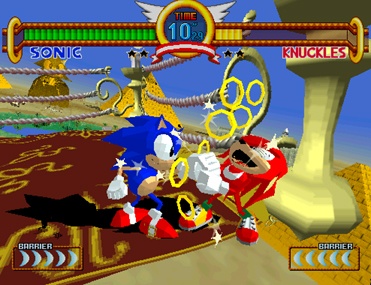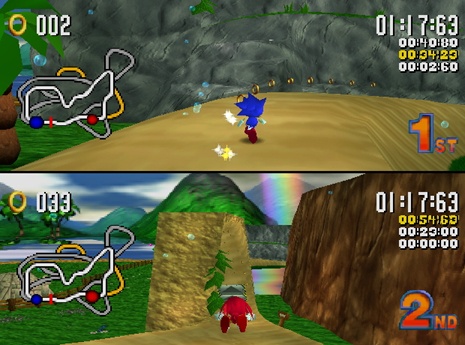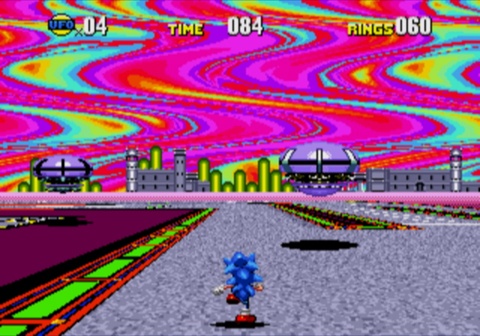Sonic Gems Collection Feature Preview
We get in Sega's latest way-back machine and take a tour of Sonic the Hedgehog's past.
The last time we saw Sega's upcoming compilation starring Sonic the Hedgehog, we got just a taste of what to expect from the collection of games culled from Sonic's wild past. The sassy blue hedgehog burst onto the scene in the early '90s and led Sega's grand and successful charge to unseat Nintendo as the undisputed champion in the console market. Though many of his finer moments were caught in the Sonic Mega Collection and Sonic Mega Collection Plus compilations that were released earlier this year, Sega has managed to find some additional tasty morsels for Sonic aficionados to sink their teeth into. We got our hands on a fairly complete version of the collection, and it contained all the games and even much of the unlockable content, which offered some surprises.

Our last look at Gems Collection was at this year's Electronic Entertainment Expo, where Sonic CD and Sonic the Fighters were available for play. Thankfully our updated build let us try out the time capsule of Sonic's exploits. When you fire up the game you'll see four options: games, manuals, museum, and extras. The games option contains the nine main games and, eventually, the unlockable games as well. You'll simply highlight the title of your choice and hop in. The manuals option lets you look at complete manuals of all nine games. Museum is a seven-page collection of 140 pieces of unlockable artwork. You'll also be able to listen to music tracks you'll unlock by playing the game, which you can toggle with the Y button. Finally, the extras option lets you read hints on the various games and check out the compilation's credits.
Now, if we can jump back to the games for a bit, we'll run you through the nine main titles, which represent highs and lows in the Sonic mythos. The first game in the collection is 1996's Sonic the Fighters, which was Sonic's second appearance in an arcade game. The game is notable for several reasons and marked a number of firsts for the versatile hedgehog, one of which was Sonic's debut in 3D. It's the only 3D Sonic fighter and, more incredibly, was developed by Sega's AM2 studio--yes, the Virtua Fighter people. The game is also one of the first to use Sega's Model 2B arcade board variant. Because of AM2's fighting pedigree, the game possesses a surprisingly solid fighting system that was in line with AM2's popular three-button system, which was introduced in the Virtua Fighter series. You'll be able to punch, kick, and block, although blocking was limited by a barrier system, so we could block only a certain number of times before running out of shields.
Though it sounds simple, the three-button setup allowed for a number of different combos as well as unique special attacks for each character. Like so many fighting games of the era, Sonic the Fighters actually featured a narrative that not only provided a solid excuse for a brawl between all the characters, but also tied in to the mythos of the console games. Basically, following the destruction of Dr. Robotnik's (as Dr. Eggman was known in those days) Death Egg station, the villain creates an even deadlier version of it called Death Egg II. Thankfully Sonic's faithful right-hand man, Tails, becomes aware of it and quickly builds a rocket to go confront Robotnik. Unfortunately, his ship only seats one, and it can be powered only by chaos emeralds, eight to be exact. So before you can say "Isn't that convenient?" the pair are setting up a fighting tournament to take on the guardians of the chaos emeralds and to determine which of the assembled is powerful enough to be sent out to take out Robotnik and Death Egg II. The game's eclectic cast of eight main fighters runs the gamut in the animal kingdom and introduces a number of new faces to the Sonic universe. Besides Sonic the Hedgehog, Miles "Tails" Prower, Knuckles the Echidna, and Amy Rose, you'll interact with newcomers such as Fang the Sniper, Espio the Chameleon, Bark the Polar Bear, and Bean the Dynamite. The colorful arcade game is re-created perfectly on the GameCube and has aged very well. The cartoony polygonal characters maintain the (at the time) cutting-edge look that caught everyone's attention back in the day with their real-time deformation. The backgrounds are equally appealing and showcase mind-boggling special effects such as real-time reflections and motion, which were eye-catching for their time.

The next game in the compilation is 1993's Sonic CD, arguably one of the most notable omissions in the original Mega Collection. The fast-paced 2D platformer hit in between Sonic 2 and 3 on the Genesis and is widely regarded as one of the best entries in the series because of the tight gameplay and a soundtrack that polarized fans. The game is a notable moment in Sonic history because of its use of the Sega CD peripheral for the Genesis console. The game's use of color and Red Book audio and its inclusion of an animated video clip are among its standout elements. From a gameplay perspective it offered some new spins on the traditional Sonic formula that had been established on the Genesis thanks to the added processing power of the CD peripheral, such as improved scaling and color. The game also introduced the concept of time travel to the mix, allowing you to warp into past- or future-themed versions of the level you were playing. The one point of contention some fans may have had with the title is that it didn't include the Japanese game's soundtrack, which some preferred over the US game's soundtrack. There is one nice perk to the game. Its animated sequence, which featured a plucky, pudgy anime-style Sonic tearing through a landscape, is full screen as opposed to the postage-stamp-sized one seen in the Genesis game. Though the game is pretty faithful to the CD version, there are load screens that we don't remember from the original Sega CD game.
Everybody's Super Sonic Racing
The third game you'll see immediately accessible in the games menu is Sonic R, a racing game that was released in 1997 for the Sega Saturn and in 1998 for the PC and was developed by UK-based Traveller's Tales. The game is infamous for a number of reasons. The game's Richard Jacques-composed soundtrack, a collection of bouncy, dance-music-style tracks, polarized fans with its inclusion of lyrics. While some fans fell in love with opuses such as "Can You Feel the Sunshine?," "Back in Time," "Work It Out," and "Super Sonic Racing," to name but a few, others unleashed an unholy shriek of disapproval. We fall into the camp of fans who count Sonic R's music as one of our guilty pleasures. The lyrics may be questionable, although undeniably catchy, but the music worked well for the game.

Sonic R's visuals are based on the PC version, which followed the Saturn release and looked quite a few notches above the console version. The PC game featured a random weather feature that helped keep the game visually interesting as you replayed the game's five tracks over and over again to unlock extra playable characters. The gameplay in Sonic R is about as polarizing as its soundtrack because the playable characters--Sonic, Tails, Knuckles, Dr. Robotnik, and Amy Rose--all handle like trucks. In the case of Amy and Robotnik, it's not a problem, since they're actually driving vehicles, but for the rest of the crew it's not so great. However, that said, once you get used to the controls, which translate fine to the GameCube controller, the game manages to offer some fun if you're willing to stick with it. Though Sonic R isn't a great game, fans who played the original might be surprised to discover that it has aged better than you'd think.
The last batch of games in the collection are six titles that appeared for Sega's Game Gear portable system--essentially its answer to Nintendo's Game Boy--from 1992 to 1995. Sonic the Hedgehog 2 is a pint-sized re-creation of Sonic's second console adventure. Sonic Spinball is a pinball game starring the blue blur. Sonic the Hedgehog Triple Trouble is an original platformer starring Sonic, Tails, and Knuckles. Sonic Drift 2 is Sonic's very own Mario Kart-style racer. Finally, the last two Game Gear games, Tails' Sky Patrol and Tails' Adventures, are original games starring Sonic's faithful sidekick, Miles "Tails" Prower. The portable games are faithfully re-created on the GameCube and showcase the cutting edge of portable technology in the early '90s. Though the games are a great inclusion for diehard fans, they haven't aged as well as the console and arcade titles, meaning that you'll likely fire them up for a look but won't play through them start to finish again unless you have a burning need for some retro action.
In addition to these nine games, Sonic Gems Collection will feature unlockable games that should provide you with a nice bit of nostalgia. Unfortunately, the games in the US version of Gems Collection are different from those found in the Japanese version of the game. Alas, anyone who cheered when word out of Japan revealed that the Japanese version of Gems Collection would feature all three installments of Streets of Rage, Sega's classic side-scrolling beat-'em-up from the 16-bit era, and Bonanza Brothers, an action game that cast you as one of two investigators who set out to clean up Badville by stopping counterfeiters and cheating casino operators, will be in for a letdown. Sonic Gems Collection will sadly not feature those games. Instead, you'll find 1995's Vectorman and its sequel, 1996's Vectorman 2. The two platformers, developed by the late, great California-based Blue Sky Software, were among the last titles for the Sega Genesis and featured impressive sprite-based graphics that pushed the system to its limits. The games are accurately brought back to life on the GameCube and maintain their platforming appeal. Sensing the beginning of an Internet petition to convince Sega to include the games from the Japanese Gems Collection in the US version, we pinged Sega to find out who exactly was smoking crack when the decision was made to omit the games, and we actually found a good reason for the omission. The sad fact of the matter is that Gems Collection's rating would have to be changed from E to T in order to include the Streets of Rage titles, and Sega opted not to change it. The upshot to this is that those games are now ready-made for a new compilation should Sega decide to make one, and the Vectorman games are pretty great platformers in their own right, so it's not like the US got stiffed too badly.
All told, Sonic Gems Collection is a solid compilation of Sonic's exploits in the '90s. Although the selection of games isn't as rich as in the original Mega Collection, the games have enough charm to warrant making this a part of your library. Sonic Gems Collection is slated to ship this August for the GameCube.
Got a news tip or want to contact us directly? Email news@gamespot.com

Join the conversation